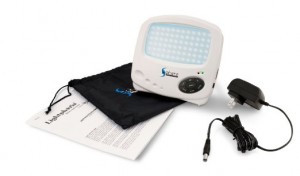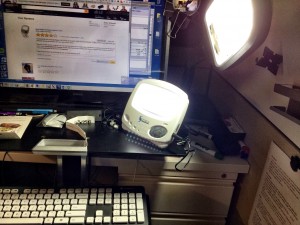I recently purchased a Lightphoria 10,000 Lux Energy Light Lamp by Sphere Gadget Technologies to try doing light therapy in the mornings at my desk. I usually arrive at work between 7-7:30am when it is barely light outside, and frequently don’t get outside again until I leave after sunset in winter.
Because I’ve done research on light box use I was aware that distance from the light makes a big difference in whether or not you get the expected dose. I have a SunSprite Wearable Light Tracker which measures light intensity. I hung this on my glasses next to my eyes and experimented with placement of the Lightphoria. What did I find?
What I found was that even with the light as close as I could comfortably get it (see photo) the amount of light at my eyes was less than the minimum reading the Sunsprite says is effective for a therapeutic effect – the Sunsprite‘s “GoodLux” reading for the Lightphoria about 12 inches from my eyes was 1.7, and the minimum it wanted to see was 2.5.
But then I thought to add in the other lamp I have on my desk for general use: a Lavish Home Sunlight Desk Lamp ! I hadn’t considered this lamp to be strong enough to act as a therapy light by itself because the description states it is only 1300 Lumens – I have it on my desk just to alleviate the sense of working in a cave because my coworkers in surrounding cubicles don’t want to have the overhead lights on and I can only see a window by standing up and looking 50 ft across other cubicle rows.
Setting the Sunlight desk lamp to point at my face in addition to the Lightphoria brings the Sunsprite reading up to an intensity of 3.6, which is sufficient to give the expected daily therapeutic exposure in about 90 minutes.
Caveat: I cannot guarantee the reliability of the Sunsprite‘s readings, but lacking any professional scientific measuring equipment I’m happy to have at least a general idea of what these light sources may be doing.
Therefore, my opinion of the Lightphoria:
PROS: small, easily transportable, timer, gives a reasonable amount of light for its small size
CONS: to get the full desired light exposure within 30-45 minutes it would need to be within literally a few inches of your face.
BOTTOM LINE: Not easy to get the medical standard level of light exposure, but not nearly as expensive as larger units, plus easy to carry/store. May be sufficient for users who don’t need a full medical intensity light.


